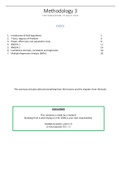💭
econometrics 2s
Consider the price of tomatoes
What features can we observe in a time series plot . . . ?
tutorial 1
tutorial 2
lecture 1: introduction
model assumptions
assumptions 1
the model is as specified and linear in parameters:
assumption 2
random sampling {yi , x1i , ..., xki }, n observations
assumption 3
there is variation in explanatory variables. no perfect collinearity (full rank of X)
econometrics 2s 1
, assumption 4
zero conditional mean
assumption 5
heteroskedasticity, constant error variance
A1 to A5 (Gauss Markov assumptions) guarantee that OLS parameter estimator
is BLUE (best linear unbiased)
assumption 6
normality of error term
the assumption implies A4 and A5
classical linear model
Gauss-Markov assumptions + A6 Inference on β can be based on t and F tests
in samples of any size.
if A6 is not valid then inference has to be justified in large sample (asymptotic
theory)
observation wise form to matrix form
same model can be represented in two ways
econometrics 2s 2
, the matrix form is much more general as it leaves the number of columns in X
unspecified
use the one that makes things easier (depending on context)
matrix form
let X be a (n×k) matrix, y be a (n×1) vector and u is a (n×k) vector of error terms
if the first column of X is a vector of ones (representing a constant) then β^1 is
the estimated constant parameter
econometrics 2s 3
, in semester 1: k was the number of explanatory variables, here it is the total
number of parameters
let X be a (n×k) matrix, Y be a (n×1) vector and u is a (n×1) vector of error terms
note: this is a symmetric matrix
random regressors
In semester 1 we assumed that X were non-random or fixed in repeated
samples.
Let’s start from this result
We established that β^ was a random variable (with a distribution) and proved
unbiasedness by taking expectations and using ZCM assumption.
econometrics 2s 4
econometrics 2s
Consider the price of tomatoes
What features can we observe in a time series plot . . . ?
tutorial 1
tutorial 2
lecture 1: introduction
model assumptions
assumptions 1
the model is as specified and linear in parameters:
assumption 2
random sampling {yi , x1i , ..., xki }, n observations
assumption 3
there is variation in explanatory variables. no perfect collinearity (full rank of X)
econometrics 2s 1
, assumption 4
zero conditional mean
assumption 5
heteroskedasticity, constant error variance
A1 to A5 (Gauss Markov assumptions) guarantee that OLS parameter estimator
is BLUE (best linear unbiased)
assumption 6
normality of error term
the assumption implies A4 and A5
classical linear model
Gauss-Markov assumptions + A6 Inference on β can be based on t and F tests
in samples of any size.
if A6 is not valid then inference has to be justified in large sample (asymptotic
theory)
observation wise form to matrix form
same model can be represented in two ways
econometrics 2s 2
, the matrix form is much more general as it leaves the number of columns in X
unspecified
use the one that makes things easier (depending on context)
matrix form
let X be a (n×k) matrix, y be a (n×1) vector and u is a (n×k) vector of error terms
if the first column of X is a vector of ones (representing a constant) then β^1 is
the estimated constant parameter
econometrics 2s 3
, in semester 1: k was the number of explanatory variables, here it is the total
number of parameters
let X be a (n×k) matrix, Y be a (n×1) vector and u is a (n×1) vector of error terms
note: this is a symmetric matrix
random regressors
In semester 1 we assumed that X were non-random or fixed in repeated
samples.
Let’s start from this result
We established that β^ was a random variable (with a distribution) and proved
unbiasedness by taking expectations and using ZCM assumption.
econometrics 2s 4










